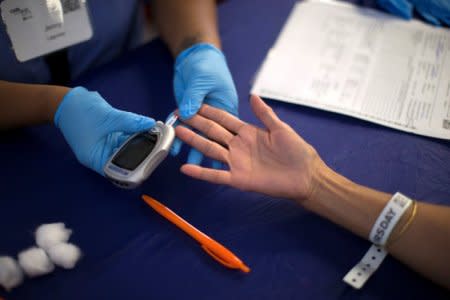Diabetic amputations on the rise in the U.S.

Thomson Reuters
By Lisa Rapaport
(Reuters Health) - - A growing number of people with diabetes in the U.S. are losing toes and feet to the disease by the time they reach middle age, according to a study that suggests a reversal after years of progress against diabetes.
When people with diabetes have poorly controlled blood sugar, over time this can restrict blood flow to the lower legs and lead to nerve damage and impaired wound healing. With a lack of sensation in the feet and lower legs, people may not notice sores and infections that develop until these problems become so extensive that they can only be addressed by amputating the damaged portion of the foot or leg.
From 2000 to 2009, the rate of so-called nontraumatic lower extremity amputations fell by 43 percent, from 5.4 cases to 3.1 cases for every 1,000 adults in the U.S with diabetes. But then amputations rebounded by 50 percent between 2009 and 2015, to 4.6 cases for every 1,000 adults with diabetes, the current study found.
The increases were most pronounced in younger adults, ages 18 to 44, and in middle-aged adults, 45 to 64, researchers report in Diabetes Care.
"We already knew that younger adults were not experiencing the same improvements in amputations over time as older adults," said senior author Edward Gregg of the Centers for Disease Control and Prevention in Atlanta, by email. "However, this is the first time we have observed an increase in amputations."
For every 1,000 adults with diabetes under age 45, the number of amputations dipped from 2.9 in 2000 to 2.1 in 2009, then climbed to 4.2 by 2015.
Among middle-aged adults, amputations per 1,000 people with diabetes went from 6.9 in 2000 to 3.8 in 2009, then to 5.4 by 2015.
In older adults, amputation rates declined from 2000 to 2009 and then held steady.
The study wasn't designed to assess whether or how any changes in diabetes treatment over time might have contributed to amputation rates.
Even so, the results suggest that many U.S. diabetes patients need more support to keep their blood sugar controlled and more education about foot care, the authors conclude.
"Amputation risk is due to a combination of impaired sensation in the feet due to nerve damage from high (blood sugar) and impaired circulation in small and larger blood vessels of the feet and legs," said Dr. Simon Heller of the University of Sheffield in the UK.
"This increases the risk of developing ulcers followed by infection and impaired healing," Heller, who wasn't involved in the study, said by email.
Patients may lower their risk of amputations by keeping blood sugar in a healthy range, not smoking and getting regular foot exams, Heller added. When foot complications do develop, amputations may be prevented by early treatment and vigilant follow-up care with a podiatrist and by wearing specially designed shoes to reduce the risk of ulcers.
SOURCE: https://bit.ly/2TvEjZG Diabetes Care, online November 8, 2018.
See Also:

 Yahoo News
Yahoo News 
